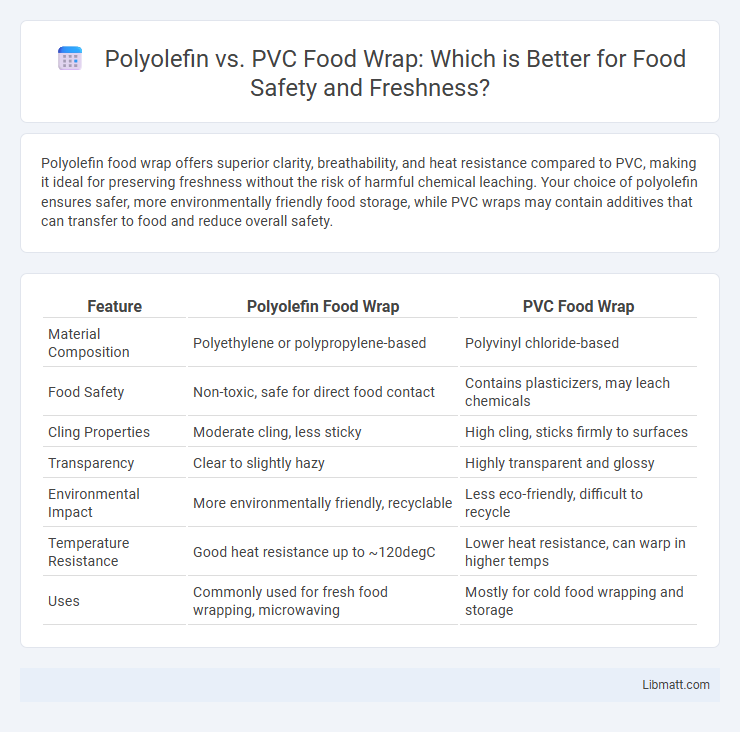Polyolefin food wrap offers superior clarity, breathability, and heat resistance compared to PVC, making it ideal for preserving freshness without the risk of harmful chemical leaching. Your choice of polyolefin ensures safer, more environmentally friendly food storage, while PVC wraps may contain additives that can transfer to food and reduce overall safety.
Table of Comparison
| Feature | Polyolefin Food Wrap | PVC Food Wrap |
|---|---|---|
| Material Composition | Polyethylene or polypropylene-based | Polyvinyl chloride-based |
| Food Safety | Non-toxic, safe for direct food contact | Contains plasticizers, may leach chemicals |
| Cling Properties | Moderate cling, less sticky | High cling, sticks firmly to surfaces |
| Transparency | Clear to slightly hazy | Highly transparent and glossy |
| Environmental Impact | More environmentally friendly, recyclable | Less eco-friendly, difficult to recycle |
| Temperature Resistance | Good heat resistance up to ~120degC | Lower heat resistance, can warp in higher temps |
| Uses | Commonly used for fresh food wrapping, microwaving | Mostly for cold food wrapping and storage |
Introduction to Food Wrap Materials
Polyolefin and PVC are two common materials used for food wraps, each offering distinct properties suited for food preservation. Polyolefin provides excellent clarity, flexibility, and resistance to heat, making it ideal for microwaving and sealing freshness. Your choice of food wrap depends on whether you prioritize breathability and safety (polyolefin) or strong cling and durability (PVC).
What is Polyolefin Food Wrap?
Polyolefin food wrap is a type of plastic film commonly used for packaging and preserving food due to its excellent clarity, flexibility, and puncture resistance. Made from polymers like polyethylene or polypropylene, it is free from harmful plasticizers and chlorine, making it a safer alternative to traditional PVC wraps. Its strong barrier properties and low permeability to moisture help extend the shelf life of food products while ensuring food safety and freshness.
What is PVC Food Wrap?
PVC food wrap is a type of plastic film made from polyvinyl chloride commonly used for preserving and covering food items. It provides excellent cling and stretchability, ensuring airtight seals that help prevent contamination and spoilage. Unlike polyolefin wraps, PVC wrap is more flexible but may release small amounts of plasticizers, making it less suitable for direct contact with fatty or acidic foods.
Composition and Manufacturing Differences
Polyolefin food wrap is made primarily from polyethylene or polypropylene, derived from polymerizing simple hydrocarbons through processes like extrusion or blown film techniques. PVC food wrap consists of polyvinyl chloride, produced by polymerizing vinyl chloride monomers with additives such as plasticizers to enhance flexibility. Understanding these composition and manufacturing differences helps you choose the best wrap for food safety and environmental impact.
Safety and Food Contact Compliance
Polyolefin food wraps are generally regarded as safer for food contact due to their inert chemical nature and compliance with FDA and EFSA regulations, minimizing the risk of harmful chemical migration. PVC wraps often contain plasticizers and additives like phthalates, which may pose health concerns and require stringent regulatory approval to ensure food safety. Choosing polyolefin wrap ensures better compliance with food safety standards, protecting your food from potential contamination.
Clarity and Breathability Comparison
Polyolefin food wraps exhibit superior clarity compared to PVC, providing a clearer, more transparent view of food items, which enhances visual appeal and freshness perception. In terms of breathability, polyolefin films allow better air circulation, reducing moisture buildup and extending the shelf life of perishable foods, whereas PVC wraps tend to trap moisture, potentially leading to faster spoilage. The combination of enhanced clarity and breathability makes polyolefin an optimal choice for preserving food quality and appearance.
Strength and Stretchability Factors
Polyolefin food wraps offer superior stretchability and moderate strength, allowing better cling and flexibility around irregularly shaped items, which aids in airtight sealing. PVC wraps generally possess higher tensile strength but lower elasticity, making them more resistant to tearing but less adaptable to stretching and forming tight seals. The balance between stretchability and strength in polyolefin makes it preferred for applications requiring both secure wrapping and flexibility, while PVC's rigidity suits scenarios where durability is paramount.
Environmental Impact: Polyolefin vs PVC
Polyolefin food wrap is more environmentally friendly than PVC because it is typically recyclable and produces fewer toxic emissions during manufacturing and disposal. PVC food wrap contains chlorine, which can release harmful dioxins and other pollutants when incinerated or discarded improperly, posing greater risks to ecosystems and human health. Choosing polyolefin over PVC reduces the environmental footprint associated with food packaging waste and chemical pollution.
Common Uses in Food Packaging
Polyolefin and PVC films are widely used in food packaging due to their distinct properties; polyolefin wraps are preferred for sealing fresh produce, bakery items, and meats because of their clarity, flexibility, and ability to shrink tightly. PVC food wraps are commonly used for short-term food storage and wrapping deli meats, cheeses, and fresh cuts of fish, benefiting from their excellent cling and barrier properties. Both materials offer effective protection against contaminants and moisture but differ in environmental impact and food safety regulations.
Choosing the Right Food Wrap: Key Considerations
When choosing between polyolefin and PVC food wraps, consider factors such as safety, environmental impact, and food preservation properties. Polyolefin wraps offer better breathability and are free from harmful plasticizers, making them a safer option for wrapping fresh produce and reducing chemical exposure. Your choice should prioritize food safety and sustainability, ensuring the wrap maintains freshness without compromising health or environmental standards.
Polyolefin vs PVC (food wrap) Infographic

 libmatt.com
libmatt.com